An online project under the direction of the CAPE ANN MUSEUM
inv. 94
View from Kettle Cove, Manchester-by-the-Sea
Good Harbor Beach, Cape Ann; View of Little Good Harbor Beach, Cape Ann
1847 Oil on canvas 20 3/8 x 30 5/16 in. (51.8 x 77 cm) Signed and dated lower left (on rock): F. H. Lane 1847
|
Related Work in the Catalog
Supplementary Images
Explore catalog entries by keywords view all keywords »
Historical Materials
Below is historical information related to the Lane work above. To see complete information on a subject on the Historical Materials page, click on the subject name (in bold and underlined).
photograph
View of Kettle Cove and Baker's Island, as depicted by Lane in his painting "View from Kettle Cove" (inv.94)
Filed under: Manchester, Mass. » // Site Photographs »
Manchester-by-the-Sea is located on Cape Ann in Essex County, Massachusetts. Incorporated in 1645, Manchester has many beaches and coves, including Manchester Harbor, and several small islands off the coast. Dubbed the Gold Coast in the nineteenth century, it became a summer destination for "rusticators", wealthy families escaping the heat of their residences in Boston, Philadelphia and New York. Among these was the famous shipbuilder and merchant Robert Bennet Forbes, who built a summer house, Masconomo, in the area known as Newport Beach in 1847. Lane painted portraits of vessels built and owned by Forbes, the "Massachusetts" and the steam bark "Antelope".
Typed transcription of photograph caption
Manchester Historical Museum, Manchester, Mass.
Also filed under: Forbes, Robert Bennet »
photograph
View of Kettle Cove and Baker's Island, as depicted by Lane in his painting "View from Kettle Cove" (inv.94)
Also filed under: Site Photographs »
map
Manchester Historical Museum
Also filed under: Forbes, Robert Bennet »
c. 1857
Manchester Historical Museum
In 1856 Robert Bennet Forbes bought nineteen acres of land for $2,800 from Israel F. Tappan in the section of the West Manchester shore known in those days as Newport. There he built Masconomo, named for the sagamore of the Agawam. In her unpublished letters to her son Robert, his wife Rose Greene Forbes wrote:
"...I think Father will put up a good sized cheap summer house, rough pillars, pine furniture etc., and very likely we shall all be there for two months next summer. He means to show people how rational people ought to live at the seaside. What nice times we shall have..."
The house was sold to Benjamin G. Boardman in 1865.
Also filed under: Forbes, Robert Bennet »
Book "Family Photographs" 1:45
Privately Printed: The Riverside Press
Collection of the Forbes House Museum.
Also filed under: Forbes, John Murray » // Forbes, Robert Bennet »
The colonial American shallop is the ancestor of many regional types of New England fishing craft found in Lane's paintings and drawings, including "New England Boats" (known as "boats"), and later descendents, such as "Chebacco Boats," "Dogbodies," and "Pinkies." (discussed elsewhere)
These boats were very common work boat types on Cape Ann throughout the 1800s. They were primarily used for inshore coastal fishing, which included lobstering, gill-netting, fish-trapping, hand-lining, and the like. They were usually sailed by one or two men, sometimes with a boy, and could be rowed as well as sailed. An ordinary catch would include rock cod, flounder, fluke, dabs, or other small flat fish. The catch would be eaten fresh, or salted and stored for later consumption, or used as bait fish. Gill-netting would catch herring and alewives when spawning. Wooden lobster traps were marked with buoys much as they are today, and hauled over the low sides of the boat, emptied of lobsters and any by-catch, re-baited and thrown back.
THE SHALLOP
Like other colonial vessel types, shallops were defined in many ways, including size, construction, and rig. Most commonly, they were open boats with square or sharp sterns, 20 to 30 feet in length, two-masted rigs, and heavy sawnframe construction which in time became lighter. (1)
The smaller shallops developed into a type called the Hampton Boat early in the nineteenth century, becoming the earliest named regional variant of what is now collectively termed the New England Boat. Other variants were named for their regions of origin: Isles of Shoals Boat, Casco Bay Boat, No Mans Land Boat, to name a few. No regional name for a Cape Ann version has survived, and "boat," or "two-masted boat" seems to have sufficed. (2)
Gloucester's New England Boats were mostly double-enders (sharp sterns) ranging in length from 25 to 30 feet, with two masts and two sails (no bowsprit or jib). They were used in the shore fisheries: handlining, gillnetting, and gathering or trapping shellfish (see View from Kettle Cove, Manchester-by-the-Sea, 1847 (inv. 94), View of Gloucester Harbor, 1848 (inv. 97), and /entry: 240/). (3)
Larger, double-ended shallops became decked and evolved in Ipswich (the part now called Essex) to become Chebacco Boats. (4) This variant retained the two-mast, two-sail rig, but evolved further, acquiring a bowsprit and jib and becoming known as a pinky (see Gloucester Harbor from Rocky Neck, 1844 (inv. 14), The Western Shore with Norman's Woe, 1862 (inv. 18), and The Old Fort and Ten Pound Island, Gloucester, 1850s (inv. 30)). The Chebacco Boat became a distinct type by the mid-eighteenth century giving rise to the pinky in the early ninetennth century; the latter, by the early 1900s. (5)
References:
1. William A. Baker, Sloops & Shallops (Barre, MA: Barre Publishing Co., 1966), 27–33; and “Vessel Types of Colonial Massachusetts,” in Seafaring in Colonial Massachusetts (Boston: The Colonial Society of Massachusetts, 1980), 13–15, see figs. 10, 11.
2. Howard I. Chapelle, American Small Sailing Craft (New York: W.W. Norton & Co., 1951), 136–45.
3. Ibid., 145, upper photo, fourth page of plates.
4. Baker, 82–91.
5. Chapelle, The American Fishing Schooners, 1825–1935 (New York: W.W. Norton & Co., 1973), 23–54.
THE NEW ENGLAND BOAT
By the 1840s, the Gloucester version of the New England Boat had evolved into a distinct regional type. Referred to locally as “boats,” the most common version was a double-ender, i.e. having a pointed stern, unlike the less common version having a square stern.
Both variants had two masts, a foresail, a mainsail, but no bowsprit or jib. Lane depicted both in several paintings, beginning in the mid-1840s (see View from Kettle Cove, Manchester-by-the-Sea, 1847 (inv. 94), View of Gloucester Harbor, 1848 (inv. 97), and /entry: 240/), all ranging 25 to 30 feet in length. In View of Gloucester Harbor, 1848 (inv. 97) and Gloucester Inner Harbor, 1850 (inv. 240), a double-ender can be seen on the beach while a square-stern version lies at anchor in the harbor, just to the right of the former. (1)
Lane’s depictions of the double-enders show lapstrake hull planking in View of Gloucester Harbor, 1848 (inv. 97) and Gloucester Inner Harbor, 1850 (inv. 240), and cuddies (short decking) inboard at the ends for shelter and stowage of fishing gear in View from Kettle Cove, Manchester-by-the-Sea, 1847 (inv. 94). The few square-stern examples (see View of Gloucester Harbor, 1848 (inv. 97) and Gloucester Inner Harbor, 1850 (inv. 240)) suggest carvel (smooth) planking and paint finish, rather than oil and tar. The presence of an example of the latter variant in Boston Harbor, as noted in Boston Harbor, c.1850 (inv. 48), suggests a broader geographical range for this subtype. (2)
The primary use of Cape Ann’s “boats” was fishing, making “day trips” to coastal grounds for cod, herring, mackerel, hake, flounder, and lobster, depending on the season. Fishing gear included hooks and lines, gill nets, and various traps made of wood and fish net.
Some boats worked out of Gloucester Harbor, but other communities on Cape Ann had larger fleets, such as Sandy Bay, Pigeon Cove, Folly Cove, Lanesville, Bay View, and Annisquam. Lane’s depictions of these places and their boats are rare to nonexistent. (3)
The double-ended boat served Lane in marking the passage of time in Gloucester Harbor. In View from Kettle Cove, Manchester-by-the-Sea, 1847 (inv. 94), we see new boats setting out to fish, but in View of Gloucester Harbor, 1848 (inv. 97) and Gloucester Inner Harbor, 1850 (inv. 240), a boat of the same type is depicted in a progressively worn state. In Stage Fort across Gloucester Harbor, 1862 (inv. 237), the boat is a stove hulk on a beach, and in the same year, Lane depicted the type’s shattered bottom frame and planking lying on the shore at Norman’s Woe in Norman's Woe, Gloucester Harbor, 1862 (inv. 1).
Regional variants of the New England Boat appear in Lane’s paintings of Maine harbors, including one and two-masted versions, collectively called Hampton Boats (see Bear Island, Northeast Harbor, 1855 (inv. 24), Ten Pound Island at Sunset, 1851 (inv. 25), Fishing Party, 1850 (inv. 50), Father's (Steven's) Old Boat, 1851 (inv. 190), and "General Gates" at Anchor off Our Encampment at Bar Island in Somes Sound, Mount Desert, Maine, 1850 (inv. 192)). Some distinctive regional types were given names, i.e. Casco Bay Boats ("General Gates" at Anchor off Our Encampment at Bar Island in Somes Sound, Mount Desert, Maine, 1850 (inv. 192) may be one), but many local type names, if they were coined, have been lost. (4)
References:
1. Howard I. Chapelle, American Small Sailing Craft (New York: W.W. Norton & Co., 1951), 141–42.
2. Ibid., 152–55.
3. Sylvanus Smith, Fisheries of Cape Ann (Gloucester, MA: Press of the Gloucester Times, 1915), 96–97, 102–05, 110–13.
4. Chapelle, 152–55.
Also filed under: Ship Models »
Also filed under: Ship Models »
The term “wherry”—variously spelled—has a long history with many hull types, some dating from the fifteenth century. (1) The version known to Lane appears to be a variant of the dory hull form and probably was developed by French and English fishermen in the Newfoundland fisheries before 1700. (2) From that time, the wherry and the dory co-evolved, their similarities the result of their construction, their differences the result of use. By the early nineteenth century, their forms reached their final states, if fragments of contemporary descriptions are any indication. (3)
By the time Lane was depicting wherries, the type (as used for fishing) resembled a larger, wider version of a dory. The extra width was due to greater bottom width (both types had flat bottoms), with a wider transom at the stern instead of the narrow, v-shaped “tombstone.” These features are easy to see in one of his drawings (see Three Men, One in a Wherry (inv. 225)) and a painting (see Sunrise through Mist, 1852 (inv. 98)), the latter depicted alongside a dory, clearly showing the differences.
No published descriptions of the uses of wherries on Cape Ann in Lane’s time have come to light, but an example in broadside view offers one use. In Becalmed Off Halfway Rock, 1860 (inv. 344), a pinky (in right foreground) has a dory and a wherry in tow, the latter loaded with a gill net for catching mackerel. (4) The greater size of the wherry is required for stowing the net, as well as setting it while the dory tows away one end to set it in way of the mackerel school.
In Lane’s time, wherries would have been used where bulky gear was called for in the coastal fisheries, i.e. gill nets, and fish traps such as pound nets, fyke nets, and lobster traps. Migrating fish schools (herring, mackerel) and shellfish were the target species.
The dory’s development was first dictated by its use in shore fishing, where small size and light weight made it easy to maneuver around rocks and shallows, and to haul ashore at the end of a day’s work. Its simple design made it easy and cheap to build. This is borne out by the standardized construction and sizes used by Simon Lowell’s boat shop at Salisbury Point, Massachusetts at the turn of the nineteenth century. Lowell called his boats “wherries,” but in Swampscott, Massachusetts, the fishermen, who used them called them “dories,” which may mark the beginning of the latter term’s wider use. (5)
The dories we see in Lane’s paintings are in virtually every way like the ones we know today. One of the best examples (see View from Kettle Cove, Manchester-by-the-Sea, 1847 (inv. 94)) even shows interior detail, including frames, leaving no doubt about its construction. Other good examples are found in Salem Harbor, 1853 (inv. 53), View of Gloucester Harbor, 1848 (inv. 97), and Sunrise through Mist, 1852 (inv. 98).
For inshore fishing, dories were used to catch mackerel and herring, either with hook and line or with small nets. Hooks and line were used for flat fish (flounder, dab, and fluke), rock cod, hake, and cunner. Eels were speared (see View from Kettle Cove, Manchester-by-the-Sea, 1847 (inv. 94)), clams were dug, and lobsters trapped. In Lane’s later years, the use of dories in trawling (setting long “trawl lines” with many baited hooks) was in its earliest. This method required six to ten dories carried on board a schooner to fish on the distant banks off New England and Canada. Early records of dory trawling in New England are fragmentary, giving the mid-1840s as the time of introduction. (6) The Gloucester-owned schooner "Anna" made a successful dory trawling trip to the Grand Banks in 1854, but no depiction of this vessel by Lane has been found or recorded. (5) Despite successful early efforts, dory trawling from Gloucester was slow to be accepted, and the fishery had very limited growth prior to 1860. (7)
– Erik Ronnberg
References:
1. M.H. Parry et al., Aak to Zumbra (Newport News, VA: The Mariners’ Museum, 2000), 634.
2. John Gardner, The Dory Book (Camden, ME: International Marine Publishing Company, 1978), 5–9.
3. Ibid., 25–29.
4. John Wilmerding, ed., Paintings by Fitz Hugh Lane (Washington, DC: National Gallery of Art, 1988), 89, 92. The “possibly discarded whaleboat” is definitely a wherry.
5. Gardner, 9, 10.
6. Wesley George Pierce, Goin’ Fishin’ (Salem, MA: Marine Research Society, 1934), 63–64.
7. Raymond McFarland, A History of New England Fisheries (Philadelphia: University of Pennsylvania, 1911), 279.
Stereograph card
Procter Brothers, Publisher
Cape Ann Museum Library & Archive
"Gloucester Harbor from Rocky Neck, Looking Southwest. This gives a portion of the Harbor lying between Ten Pound Island and Eastern Point. At the time of taking this picture the wind was from the northeast, and a large fleet of fishing and other vessels were in the harbor. In the range of the picture about one hundred vessels were at anchor. In the small Cove in the foreground quite a number of dories are moored. Eastern Point appears on the left in the background."
Southeast Harbor was known for being a safe harbor.
Also filed under: Gloucester Harbor, Outer » // Historic Photographs » // Rocky Neck » // Schooner (Fishing) »
Also filed under: Chebacco Boat / Dogbody / Pinky » // Ship Models »
Gloucester, MA
4 x 33 1/2 x 7 1/4 in (10.16 x 85.09 x 18.415 cm)
Peabody Essex Museum
Also filed under: Objects » // Ship Models »
For centuries the Thacher Island Twin Lighthouses, or Cape Ann Light Station, have guided mariners off Cape Ann to safety. Thacher Island is a 52-acre island located on the eastern shore of Rockport, MA about a half-mile offshore and has been visited by Europeans as early as 1605, but didn't have a light station until 1771. On December 21, 1771 two 45-foot stone towers were lit on Thacher Island to mark the dangerous Londoner Ledge to the southeast of Thacher Island. These Thacher Island Twin Lighthouses were the 11th and last lighthouses to be built under the British occupation of the colonies. In the century after the original towers were built, the Cape Ann Light Station underwent numerous changes. New lamps were installed in 1810, a two-story wooden keepers house was built in 1840, a fog bell was added in 1853, but the most substantial change came in 1861 when the Thacher Island Twin Lighthouses were rebuilt. First lit on October 1, 1861, the formidable 124-foot-tall towers were built from New Hampshire Granite and boasted first-order Fresnel lens, making each of the lights visible from 22 miles away. A three-story keeper's house was built the same year and housed two separate families. Fitz Henry Lane depicted the Cape Ann Light Station on at least two occasions; the works date to the 1850s and 1861.
This information has been shared with the Lane project by Jeremy D'Entremont. More information can be found at his website, www.newenglandlighthouses.net or in The Lighthouse Handbook New England. This information has also been summarized from Paul St. Germain's book, Lighthouses and Lifesaving Stations on Cape Ann.
Newsprint
Cape Ann Advertiser
Collection of Fred and Stephanie Buck
"VISIT TO LANE'S STUDIO.
We called at the studio of this artist a few days ago, and found several new paintings had been added to his collection since our last visit. The first that arrested our attention was a view of Good Harbor Beach. . . .
A scene outside Eastern Point, during a fresh sou'wester, is full of life, and faithfully portrayed on the canvass. . . .
A fancy sketch, representing a storm scene, is also on exhibition. . . .
The Artist has now on his easel a large picture 36x60, just commenced, which we should judge would be his master-piece. It will be on exhibition when finished, and we forbear a description of it at this time. Mr. Lane, as a marine painter, ranks first in the country, and we are pleased to chronicle his success in producing such life-like pictures."
Also filed under: Cod / Cod Fishing » // Fishing » // Newspaper / Journal Articles » // Studio Descriptions » // Thacher Island »
Newspaper clipping
Cape Ann Advertiser
Collection of Fred and Stephanie Buck
About a visit to the new lighthouse:
"VISIT TO THATCHER'S ISLAND.
On Wednesday last, the yacht Mary Bell, Capt. Merchant, made an excursion to Thatcher's Island. Availing ourselves of an invitation we joined the party and were soon on our way with a brisk breeze, which wafted us speedily to our destination. Arriving at the Island we landed and proceeded to examine the new lighthouses which have recently been erected here, and are now nearly ready for service. The towers are the most substantial that have been erected on the American coast, and reflect great credit on those who have had the superintendence of their construction. . . "
Also filed under: Newspaper / Journal Articles » // Thacher Island »
Photograph
From The Illustrated Coast Pilot with sailing directions. The Coast of New England from New York to Eastport, Maine including Bays and Harbors, published by N. L. Stebbins, Boston, Mass.
Also filed under: Thacher Island »
Stereograph card
Cape Ann Museum Library & Archive
Also filed under: Historic Photographs » // Thacher Island »
Stereograph card
Cape Ann Museum Library & Archive
Also filed under: Historic Photographs » // Thacher Island »
Stereograph card
Cape Ann Museum Library & Archive
Also filed under: Historic Photographs » // Thacher Island »
288 individual prisms are mounted in a brass frame, the whole structure measuring 9 ft. 4 in. high and 6 ft. 5" diameter.
Cape Ann Museum. On permanent loan from the United States Coast Guard, 2013
Installed in south light tower, 1861; removed, 1980.
Also filed under: Objects »


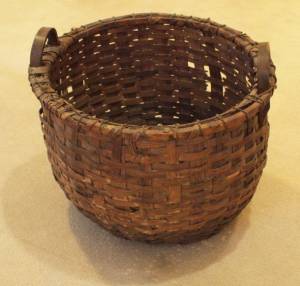
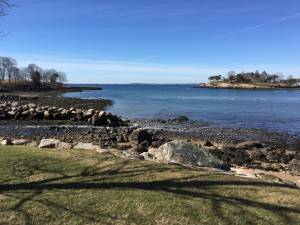
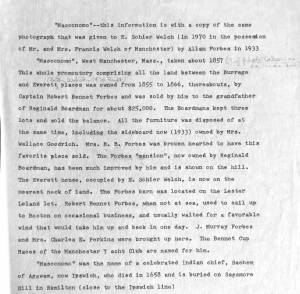
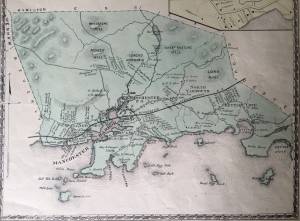
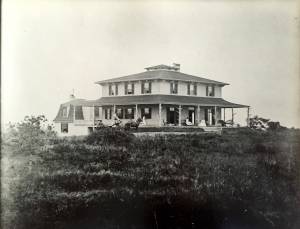
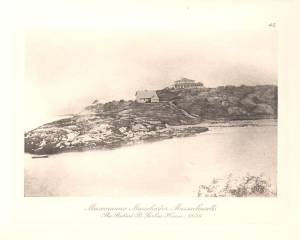

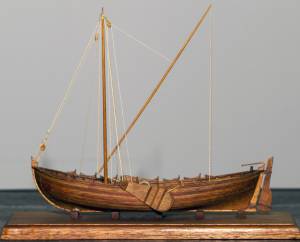
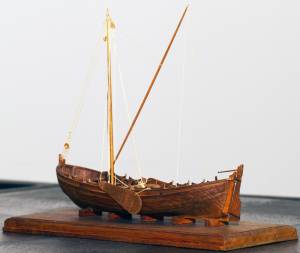
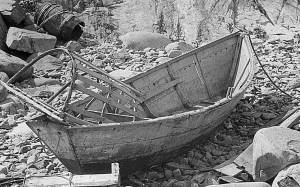


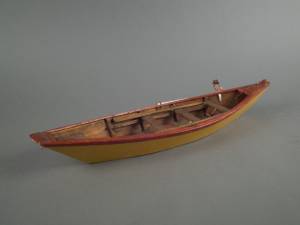
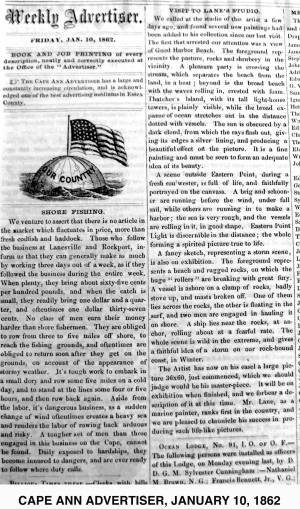
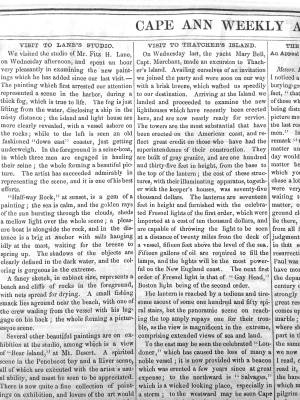
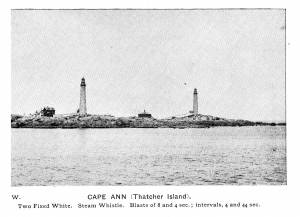

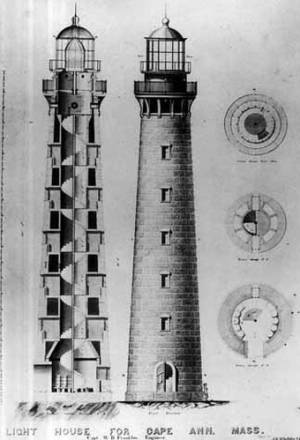
Commentary
The lack of wind and calm conditions of this early morning scene are apparent in the efforts being made by the crew of the two classic New England boats to get out into clear water where they will be able to get some wind in their sails. The vessel in the immediate foreground is being pushed off the beach by one crewmember while the other crewmember poles off the shore. Similarly, the more distant New England boat is being rowed with sweeps (long oars) as the crew unfurls the foresail, the other sail hanging loosely in the calm air.
As Erik Ronnberg has observed in conversation, “The watercraft in this painting are of interest, particularly the two-masted double-ended boats called New England boats. Descendants of colonial shallops, they were commonly used in the shore fisheries throughout the nineteenth century and into the twentieth. This is one of Lane's earliest depictions of the type, which reappears in several of his Gloucester Harbor scenes over the years, and in progressive states of deterioration.”
Sails further out in the bay seem to be catching a bit more breeze, and the mackerel fleet can be seen on the horizon, heading for the distant fishing grounds of George’s Bank. A fisherman is hauling in the gill net he set the night before, hoping for a rich catch of herring or mackerel. A brig ghosts along in the middle distance, also trying to catch a breath of the elusive wind to propel it offshore as it departs Cape Ann for distant lands.
The jaunty, anecdotal character typical of Lane’s early work is captured in the farmer with horse and cart bringing his carrots to market; the driver is depicted very realistically, for Lane, whose figures are usually fairly secondary to his compositions. The strong horizontal of the road in the foreground with the solid horse and cart catches the eye initially; then the composition directs the eye to the poling fisherman to the right; from there to the rocks on the tip of Crow Island, glowing in the summer morning sun; and finally off to the bright sails of the fishing fleet, glinting on the far horizon. In the center of the canvas is Baker’s Island, which then had twin lights (“Ma and Pa Baker”). “Ma Baker” was later dismantled, leaving the light that is still there today.
The similarity between the Baker Island lights and the famous twin lighthouses of Thacher's Island may be the reason for the (incorrect) alternate title of Good Harbor Beach, Cape Ann. Lane clearly spent some time sketching in Manchester, as shown in several drawings; the one most similar to this painting is From West Manchester Shore, 1850s (inv. 162) which shows Baker's Island from a slightly different perspective. His patron Robert Bennet Forbes built a summer house in West Manchester in the area known as Newport Beach, which is depicted in one of Lane's drawings, View from Newport Beach near Manchester (inv. 165).
This is a delightfully detailed and evocative work, all the more enjoyable through its nostalgic depiction of an identifiable piece of Cape Ann from an earlier era.
– Alison Anholt-White
[+] See More